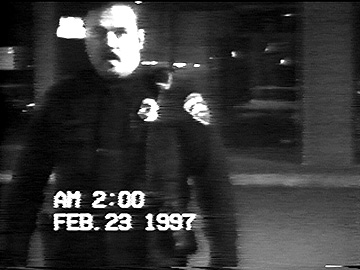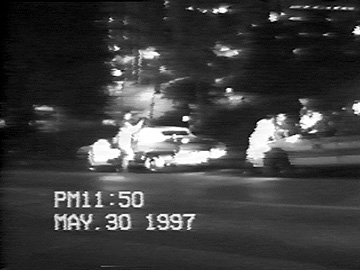Greg Jackson's eyebrows ride up his scalp in amazement as he tells of a raid the Seattle police carried out the night before. It is Thanksgiving morning and someone in the community has called to report that the Teen Life Center, a new grassroots study group at the old Garfield Community Center, has been raided by police, 8-deep. Reportedly, all of the children there were herded out and two, ages 11 and 12, were arrested. The officers said the children were going to be taken to the DSHS (Department of Social and Human Services), as they led them out in handcuffs. A police spokesperson said that the two children were runaways, and that they are routinely placed in handcuffs whenever they must ride in a police vehicle. They are not necessarily read their rights.
A few hours later someone calls with the news that a friend has been shot at a downtown club where he had gone to dance. Greg Jackson passes the news along the grapevine, and offers sympathy to the next caller, who knew the victim. One of the goals of Black Autonomy, the group Mr. Jackson is a part of, is to interrupt the cycle of violence in Seattle's African American community.
Founded in 1994, Black Autonomy publishes a newspaper, has been active in the Central area Umoja Festival and parade, and provides security for shows and concerts. Their goal is to create a self-sufficient African American community, where everything is owned and operated by African Americans. But they are probably best known for bringing back a tradition inspired by the Black Panthers, the Copwatch.
As practiced by the Black Panthers the Copwatch was a defensive gesture. Panthers, harrassed and tailed by police, began to arm themselves and confront the police with weapons drawn.

Armed With the Law
A small cadre of community members coordinated by Greg Jackson and calling themselves Copwatch 206 regularly confronts police armed only with their cameras and the law (revised title codes 9 and 10 of the state of Washington, and knowledge of the Miranda code.) Dressed in khaki colored uniforms, carrying badges and ID, Copwatch 206 scans the Central District for signs of police activity and rolls to the scene. Once there members of the group begin documenting the police action, taking badge numbers, snapping photos, and making note of the location. Their uniforms help give them an identity to the police officers, and to the suspect, or 'victim', as Jackson calls them. "We've had police try to get a rise out of the victim by saying 'Hey you're going to be on candid camera!', 'America's Most Wanted is here!'. The uniform and badge lets people know what we're really about. Witnesses to a Copwatch/Police encounter often feel empowered enough to want to participate in the organization.
More recently police have begun using cell phones to communicate, making it more difficult to monitor their wheareabouts (and taking their communications out of the public record). However, you don't have to be on a copwatch to be on duty. "Sometimes I'll just have my camera with me and come up on something," says Mr. Jackson. The goal is to monitor police activity and make sure that, at a minimum, people's civil rights are being respected.
Other communities have shown an interest in starting their own copwatches, Mr. Jackson was invited to the Lumni Reservation, as well as at the recent APEC conference to speak to protesters there. For a short time there was a copwatch in the University district. Mr. Jackson blames its demise on the lack of a coherent community.
Inspired to Act
Copwatchers are on the lookout for incidents like the one which resulted in the 1995 slaying of Edward Anderson as he was chased from his Central District backyard. Anderson, unarmed, was shot in the back as he fled from Seattle police responding to a domestic violence call. It was this incident that inspired the group of concerned youth, including members of the Pan-African student movement, to form a group to keep a closer eye on the people roaming their community with "the power of life and death strapped to their hip," as Jackson puts it. Another Seattle group, Mothers Against Police Harrassment sometimes works with Black Autonomy to monitor the police.
"Edward Anderson was shot in 1995 and we were on the road in 1996," says Mr. Jackson. They spent a year researching the law and the police. They looked up the codes, got a copy of a police training manual, and planned their approach. "We decided to come at the police with cameras, to document and help the victim (of police harrassment) however we can."
Once a Copwatch has observed an incident, the next step is following up on the case to see whether the person taken into custody was ever actually charged. This requires getting police reports, which takes time that Copwatch 206 does not usually have. Mr. Jackson also says that they have been frustrated by a police department that claims police reports are not available because they are "pending police investigation."

Mixed Feelings
A police cruiser is not hard to find in the Central District, an area roughly formed by I-90 on the south, Madison to the North, 12th Ave and MLK/Leschi to the east. For most people living in this neighborhood the Seattle police are a constant visual presence, but residents of the area have mixed feelings about the level of surveillance.
One older black man said he wished there were more police in the CD, while one woman hadn't noticed any police presence at all. Another African-American resident said that her son and daughter are routinely pulled over by police, and that her daughter was recently issued a ticket without being told what it was for, leaving them both nervous, angry and confused. A white couple said they had noticed less of a police presence lately, but felt it was definitely necessary. No one's answer to the question of police presence in the CD came without a strong flash of anger or fear.
Sometimes the dynamic between Copwatch and the police can become more charged than that between the police and the suspect. Mr. Jackson laughs at the Keystone Cops style reaction to Copwatch that he has seen. "They don't know what to make of us. Once we came on a scene where the police had someone spread on a car - they saw us pointing our cameras and one of the officers (he calls them by their badge numbers) came over and said 'you can get that camera out of my face or you and the camera can go to jail.'" Mr. Jackson didn't flinch, "I said, 'Revised codes 9 and 10 of Washington clearly state that I can film you.' The other officer runs up on another [copwatcher] and says, 'Why you gotta be so hostile?' I said, 'It's your friend who's yelling.'" In the meantime the suspect detained by the police had taken advantage of the confusion and simply walked away. Mr. Jackson also claims to have been 'mooned' by a Seattle Police Officer from the window of a moving cruiser.
Official Support
The police reaction to Copwatch has gotten less charged over time. Copwatch has the support of Police Chief Norm Stamper. Mr. Jackson seems proud to say that he has "Stamper's private line," and has spoken to him at several public forums. A police spokesperson states, "There are a number of groups who routinely watch out for public safety and quite frankly we think it's a good thing. How can we gain public confidence if we don't allow them to be involved?" Many think a citizen review board would be a good start.
Three years after the death of Edward Anderson, many police officers are still unaware that Copwatch 206 exists. "I just do my job," says one. "I've never heard of any group like that."
Mr. Jackson says that the police in the Central District have changed: "They are less likely to run up on you." He claims that the impact of Copwatch's activities can be measured mostly in the attitude of the community. According to him, the community is much more aware and involved than it was when they first started. "It used to be people saw someone getting jacked up they would walk on by. Now we get calls to report this stuff."
 |
 |
 |
 |
 |
Contents this page were published in the January/February, 1998 edition of the Washington Free Press.
WFP, 1463 E. Republican #178, Seattle, WA -USA, 98112. -- WAfreepress@gmail.com
Copyright © 1998 WFP Collective, Inc.